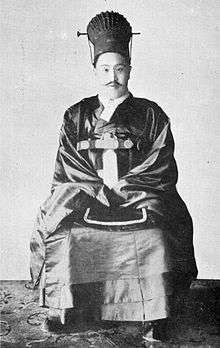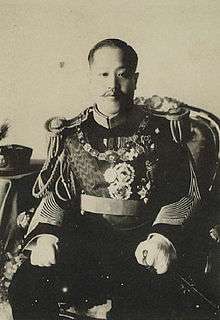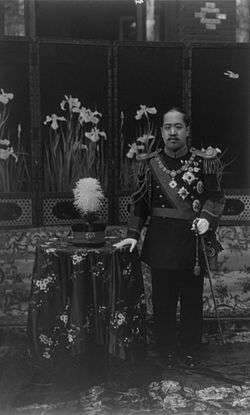Sunjong of Korea
| Sunjong | |
|---|---|
| Emperor of Korea | |
 | |
| Emperor of Korea | |
| Reign | 20 July 1907 – 29 August 1910 |
| Predecessor | Gojong of Korea |
| Successor | Empire abolished |
| Emperor of Korea | |
| Pretend | 29 August 1910 – 24 April 1926 |
| Successor | Yi Eun, Crown Prince Euimin |
| Born |
25 March 1874 Changdeok Palace, Seoul, Korea |
| Died |
24 April 1926 (aged 52) Changdeok Palace, Keijo (Seoul), Japanese Empire |
| Burial | Yureung |
| House | House of Yi |
| Father | Gojong of Korea |
| Mother | Empress Myeongseong |
| Korean name | |
| Hangul | 순종 융희제 |
|---|---|
| Hanja | 純宗 隆熙帝 |
| Revised Romanization | Sunjong Yunghuije |
| McCune–Reischauer | Sunjong Yung'huije |
| Pen name | |
| Hangul | 정헌 |
| Hanja | 正軒 |
| Revised Romanization | Jeongheon |
| McCune–Reischauer | Chŏnghŏn |
| Birth name | |
| Hangul | 이척 |
| Hanja | 李坧 |
| Revised Romanization | I Cheok |
| McCune–Reischauer | Yi Ch'ŏk |
| Courtesy name | |
| Hangul | 군방 |
| Hanja | 君邦 |
| Revised Romanization | Gunbang |
| McCune–Reischauer | Kunbang |
Sunjong, the Emperor Yunghui (Hangul: 융희제; Hanja: 隆熙帝; RR: Yunghuije; MR: Yunghŭije; 25 March 1874 – 24 April 1926),[1] was the second and the last Emperor of Korea, ruling from 1907 until 1910. He was the last ruler of the Yi dynasty.
Biography
Sunjong was the fourth son of Gojong, the Emperor Gwangmu and Empress Myeongseong. Sunjong, also known as 'Lee Cheok' was proclaimed as the crown prince at the age of two years old. In 1882, he married Princess Min Crown, who became Empress Sunmyeonghyo (Hangul: 순명효황후; Hanja: 純明孝皇后)).

The Korean Empire was established in 1897 and Sunjong became the empire's royal prince. In July 1907, Gojong was deposed as a result of coercion by Japanese Imperialism and the betrayal of pro-Japanese politicians. Crown Prince LeeCheok (Sunjong) was made Emperor Yung-hui (Hangul: 융희; Hanja: 隆熙) when Japan forced the abdication of Emperor Gwangmu in 1907. He was proclaimed as heir to the throne of Yeongchin King (Hangul: 영친왕; Hanja: 英親王) who was the younger brother of Sunjong. He moved his residence from Deoksugung palace to Changdeokgung palace.[2]
Sunjong ruled for just three years. His reign was limited by the gradual Japanese armed intervention in Korea. On July 1907, Sunjong became an emperor and immediately and forcibly entered into the Japan-Korea Treaty of 1907 (Hangul: 한일신협약, 정미7조약; Hanja: 韓日新協約, 丁未七條約). This allowed Japanese supervision and intervention in the administration of the Korean Empire which also allowed for appointment of Japanese ministers within the Korean Empire.[3]
While under Japanese supervision, the Korean Empire's Army was dismissed on the pretext of lack of public finance regulations. In 1909, Japan implemented the 'Kiyu protocol' (Hangul: 기유각서; Hanja: 己酉覺書) which effectively removed the Korean Empire's judicial power. Also, Japanese Imperialism passed the 'Policy about Japanese annexation of Korea'. Japan assigned Ito Hirobumi to negotiate with Russia about the problems of Korea and Manchuria. However, Ito was assassinated by Ahn Jung-geun at Harbin, forcing Japan to begin occupying Korea. Eventually, pro-Japanese politicians like Song Byung-jun and Lee Wan-yong defected, merging Korea with Japan by fabricating Korea's willingness and establishing a treaty on August 29, 1910. The treaty is called Japan-Korea Treaty of 1910.[4][5]
Sunjong's reign ended with the Japan-Korea Annexation Treaty in August 1910. Japan then abolished the Korean Empire, ending 519 years of Korean rule under the same family.[6] After the annexation treaty, the former emperor Sunjong and his wife, Empress Sunjeong, lived the rest of their lives virtually imprisoned in Changdeokgung Palace in Seoul.[7] Sunjong could not exercise his force as an emperor because there were only pro-Japanese politicians in government. After the Korean Empire collapsed under Japan's force, Sunjong was demoted from Emperor to King. Japan treated him with respect as 'Changdeokgung Yi King' (Hangul: 창덕궁 이왕; Hanja: 昌德宮 李王) and permitted that the title of the King could be inherited.[2]
After abdication


Sunjong died on 24 April 1926 in Changdeokgung and is buried with his two wives at the imperial tomb of Yureung (유릉, 裕陵) in the city of Namyangju. His state funeral on 10 June 1926 was a catalyst for the June 10th Movement against Japanese rule.[8]
Family
- Father: Emperor Gojong (고종)
- Mother: Empress Myeongseong of the Yeoheung Min clan (명성황후 민씨, 1851–1895)
- Consorts:
- Empress Sunmyeong of the Yeoheung Min clan (순명황후 민씨, 1872–1904) – born to Min Tae-ho, leader of the Yeoheung Min clan; relative of Empress Myeongseong. She died before her husband was enthroned.
- Empress Sunjeong of the Haepyeong Yun clan (순정황후 윤씨, 1894–1966) – daughter of Marquis Yun Taek-yeong.
His full posthumous name
- His Imperial Majesty Emperor Sunjong Munon Muryeong Donin Seonggyeong of Korea
- 대한제국순종문온무령돈인성경황제폐하
- 大韓帝國純宗文溫武寧敦仁誠敬皇帝陛下
- Daehan Jeguk Sunjong Munon Muryeong Donin Seonggyeong Hwangje Pyeha
Ancestry
| Ancestors of Sunjong of Korea | |||||||||||||||||||||||||||||||||||||||||||||||||||||||||||||||||||||||||||||||||||||||||||||||||||||||||||||||||||||||||||||||||||||||||||||||||||||||||||||||||||||||||||||||||||||||||||||||||||||||||||||||||||||||||||||||||||||||||||||||||||||||||||||||||||||||||||||||||||||||||||||||||||||||||||||||||||||||||||||||||||||||||||||||||||||||||||||||||
|---|---|---|---|---|---|---|---|---|---|---|---|---|---|---|---|---|---|---|---|---|---|---|---|---|---|---|---|---|---|---|---|---|---|---|---|---|---|---|---|---|---|---|---|---|---|---|---|---|---|---|---|---|---|---|---|---|---|---|---|---|---|---|---|---|---|---|---|---|---|---|---|---|---|---|---|---|---|---|---|---|---|---|---|---|---|---|---|---|---|---|---|---|---|---|---|---|---|---|---|---|---|---|---|---|---|---|---|---|---|---|---|---|---|---|---|---|---|---|---|---|---|---|---|---|---|---|---|---|---|---|---|---|---|---|---|---|---|---|---|---|---|---|---|---|---|---|---|---|---|---|---|---|---|---|---|---|---|---|---|---|---|---|---|---|---|---|---|---|---|---|---|---|---|---|---|---|---|---|---|---|---|---|---|---|---|---|---|---|---|---|---|---|---|---|---|---|---|---|---|---|---|---|---|---|---|---|---|---|---|---|---|---|---|---|---|---|---|---|---|---|---|---|---|---|---|---|---|---|---|---|---|---|---|---|---|---|---|---|---|---|---|---|---|---|---|---|---|---|---|---|---|---|---|---|---|---|---|---|---|---|---|---|---|---|---|---|---|---|---|---|---|---|---|---|---|---|---|---|---|---|---|---|---|---|---|---|---|---|---|---|---|---|---|---|---|---|---|---|---|---|---|---|---|---|---|---|---|---|---|---|---|---|---|---|---|---|---|---|---|---|---|---|---|---|---|---|---|---|---|---|---|---|---|---|---|---|---|---|---|---|---|---|---|---|---|---|---|---|---|---|---|---|---|
| |||||||||||||||||||||||||||||||||||||||||||||||||||||||||||||||||||||||||||||||||||||||||||||||||||||||||||||||||||||||||||||||||||||||||||||||||||||||||||||||||||||||||||||||||||||||||||||||||||||||||||||||||||||||||||||||||||||||||||||||||||||||||||||||||||||||||||||||||||||||||||||||||||||||||||||||||||||||||||||||||||||||||||||||||||||||||||||||||
| Joseon dynasty monarchs | ||||||||||||||||||||||||||||||||||||||||||||||||||||||
|---|---|---|---|---|---|---|---|---|---|---|---|---|---|---|---|---|---|---|---|---|---|---|---|---|---|---|---|---|---|---|---|---|---|---|---|---|---|---|---|---|---|---|---|---|---|---|---|---|---|---|---|---|---|---|
|
||||||||||||||||||||||||||||||||||||||||||||||||||||||
See also
References
- ↑ "Korea. Choson. The Yi Dynasty Genealogy". Buyers, Christopher: The Royal Ark. Retrieved 2015-04-11.
- 1 2 "The Academy of Korean Studies(한국학중앙연구원) : 순종(Sunjong)".
- ↑ "『고종시대사 6』(History of Gojong's Period 6) : 국사편찬위원회(National History Compilation Committee), 1969, 635p".
- ↑ "『고종시대사 6』(History of Gojong's Period 6) : 국사편찬위원회(National History Compilation Committee), 1969, 641p".
- ↑ Rhee, Song Nai. Beautiful as the Rainbow: Nashimoto Masako, a Japanese Princess against All ... p. 100.
- ↑ "::: Cultural Heritage, the source for Koreans' Strength and Dream :::". Cultural Heritage Administration of Korea. Retrieved 2 September 2013.
- ↑ "Emperor Sunjong of Korea". Asian History. Retrieved 2 September 2013.
- ↑ Yunghui Yi Cheok, Emperor Sunjong. Korea's Last Emperor's Goodbye: Korea Annexed by Japan. 1915.
| Sunjong of Korea Born: 25 March 1874 Died: 24 April 1926 | ||
| Regnal titles | ||
|---|---|---|
| Preceded by Gwangmu Emperor |
Emperor of Korea 20 July 1907 – 29 August 1910 |
Empire dissolved |
| Titles in pretence | ||
| Loss of title | — TITULAR — Emperor of Korea 29 August 1910 – 24 April 1926 Reason for succession failure: Empire abolished in 1910 |
Succeeded by Crown Prince Euimin |
.svg.png)
